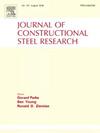Deflection calculation for tapered GBCSWs considering the negative and positive Resal effects
IF 4
2区 工程技术
Q1 CONSTRUCTION & BUILDING TECHNOLOGY
引用次数: 0
Abstract
Owing to the reduced shear stiffness and the accordion effect of corrugated steel webs (CSWs), accurately predicting the deflection of girder bridges with CSWs (GBCSWs) requires particular attention to the shear deflection occurring within the CSWs. Traditional deflection calculation theories for GBCSWs assume that the CSWs fully resist shear forces, resulting in shear deflection. Meanwhile, the concrete flanges are assumed to bear the entire bending moment, contributing to bending deflections. However, this study demonstrates that these assumptions are insufficient for accurately predicting deflections in tapered configurations. In tapered GBCSWs, the Resal effect induces additional shear forces within the CSWs, resulting in additional shear deflection that significantly affects the total deflection, a phenomenon that is absent in prismatic GBCSWs. Additionally, this study represents the first comprehensive investigation of the Resal effect, revealing its dual influences—both positive and negative—on the deflection behavior of tapered GBCSWs. The positive Resal effect contributes to a decrease in the effective deflection of GBCSWs, whereas the negative Resal effect results in an increase in deflection. Failure to account for the Resal effect and the use of traditional methods for calculating deflections in tapered GBCSWs can lead to considerable inaccuracies. This research not only investigates but also clarifies the mechanisms by which the Resal effect influences the deflection behavior in tapered GBCSWs. Additionally, modified formulas for predicting the deflection of tapered GBCSWs are proposed. The accuracy of the modified method was validated through experiments and numerical simulations.
求助全文
约1分钟内获得全文
求助全文
来源期刊

Journal of Constructional Steel Research
工程技术-工程:土木
CiteScore
7.90
自引率
19.50%
发文量
550
审稿时长
46 days
期刊介绍:
The Journal of Constructional Steel Research provides an international forum for the presentation and discussion of the latest developments in structural steel research and their applications. It is aimed not only at researchers but also at those likely to be most affected by research results, i.e. designers and fabricators. Original papers of a high standard dealing with all aspects of steel research including theoretical and experimental research on elements, assemblages, connection and material properties are considered for publication.
 求助内容:
求助内容: 应助结果提醒方式:
应助结果提醒方式:


